The inaugural CONCACAF Central American Cup Final is fast approaching. The stage is set for the highly anticipated two-legged clash between Alajuelense and Real Estelí.
The Costa Rican giants bring a legacy of success into the finals with an impressive record of 30 league titles and two CONCACAF Champions Cups, meaning they emerge as the probable favourites in this matchup. For those not acquainted with Alajuelense, one recognisable name is that of former Arsenal player, Joel Campbell. The 31-year-old forward has returned to his native Costa Rica after navigating something of a journeyman career which has seen him play in Ligue 1 and La Liga, respectively. Additionally, young players such as Doryan Rodríguez and Aarón Suárez have played crucial roles in the club’s journey to the final.
Meanwhile, Real Estelí are a force to be reckoned with in Nicaraguan football. Their path to the final has been defined by resilience and a never-say-die attitude. Ontiel Olivas has instilled a disciplined approach that centres around defensive solidity, tactical discipline, and knowing when to exploit their attacking opportunities.
The first leg will take place on Tuesday night in Nicaragua, with Real Estelí having the home advantage. The return leg in Costa Rica will take place one week later, after which we will know which team are the 2023 Central American Champions.
As the final approaches, we are going to delve into what looks to be an exciting matchup between the two sides. This tactical analysis will take a look at what we can expect from each team. We will analyse the tactics we expect each manager to utilise and how they will set up.
Alajuelense
Andrés Carevic mostly utilises a 4-2-3-1 or a 4-4-2 system; both systems are very similar and provide him with the attacking freedom he desires whilst retaining the all-important defensive structure. In this section of the analysis, we will take a look at what tactics Carevic could look to utilise in the final.
A lethal attack
Alajuelense’s lethal attack has been a key component in their journey to the final. They have netted 20 goals in their eight games so far, averaging 2.5 per game from an xG of 2.03 per 90 from 15.5 shots per 90. They like to hit their opponents early, in five of their last six Central American Cup games, Alajuelense have scored within the first ten minutes. Carevic likes his team to establish their dominance and not give their opponents time to settle into the game.
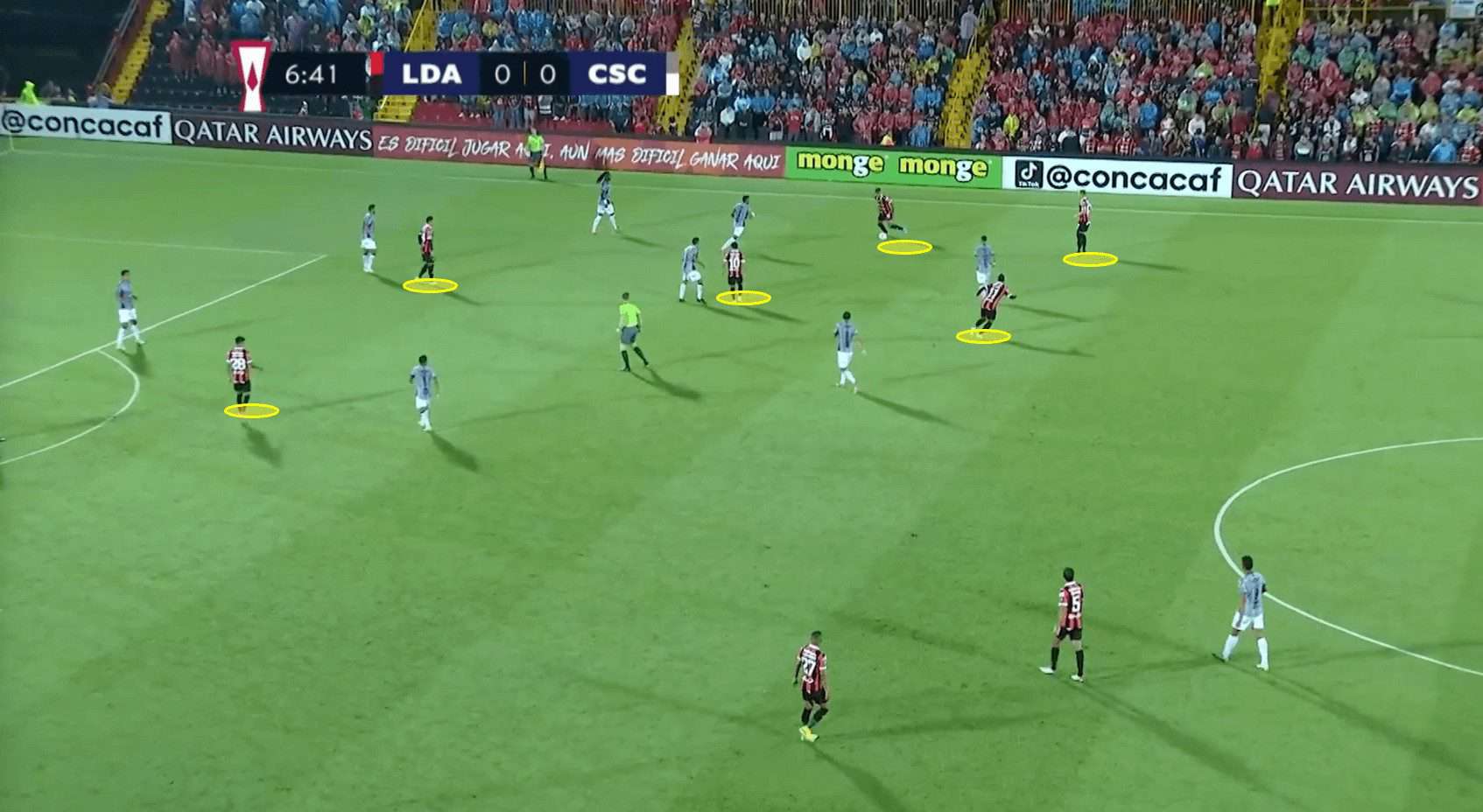
When attacking, Alajuelense looks to create overloads on one side of the pitch before quickly executing a switch. By overloading one side, they aim to draw the attention and defensive resources of the opponent to that specific area, as demonstrated above. This is achieved by committing more players to one flank, outnumbering the opposition in that region. The goal here is to create numerical superiority, forcing the defensive team to shift and adjust their formation to cope with the concentrated attacking threat.
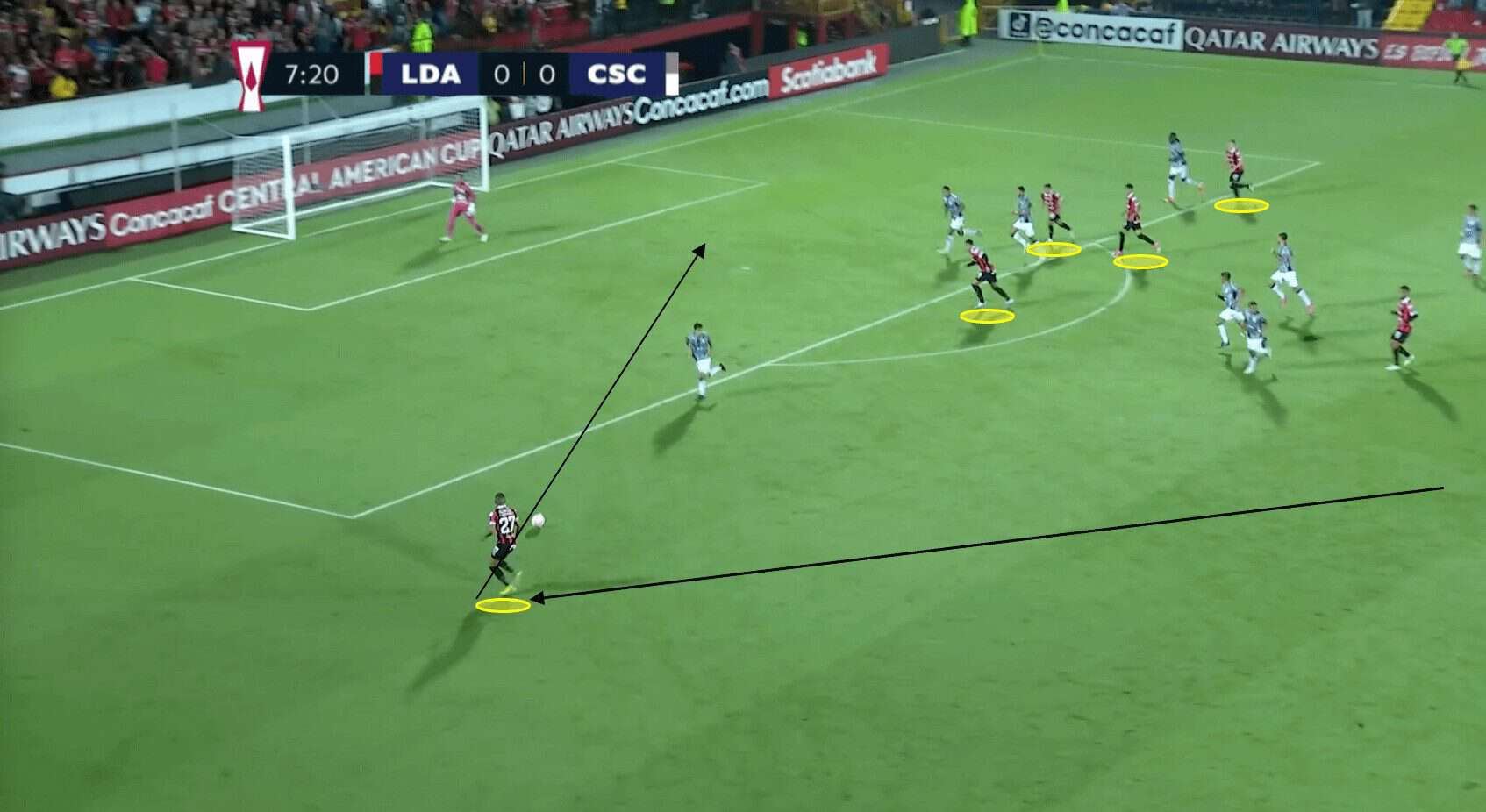
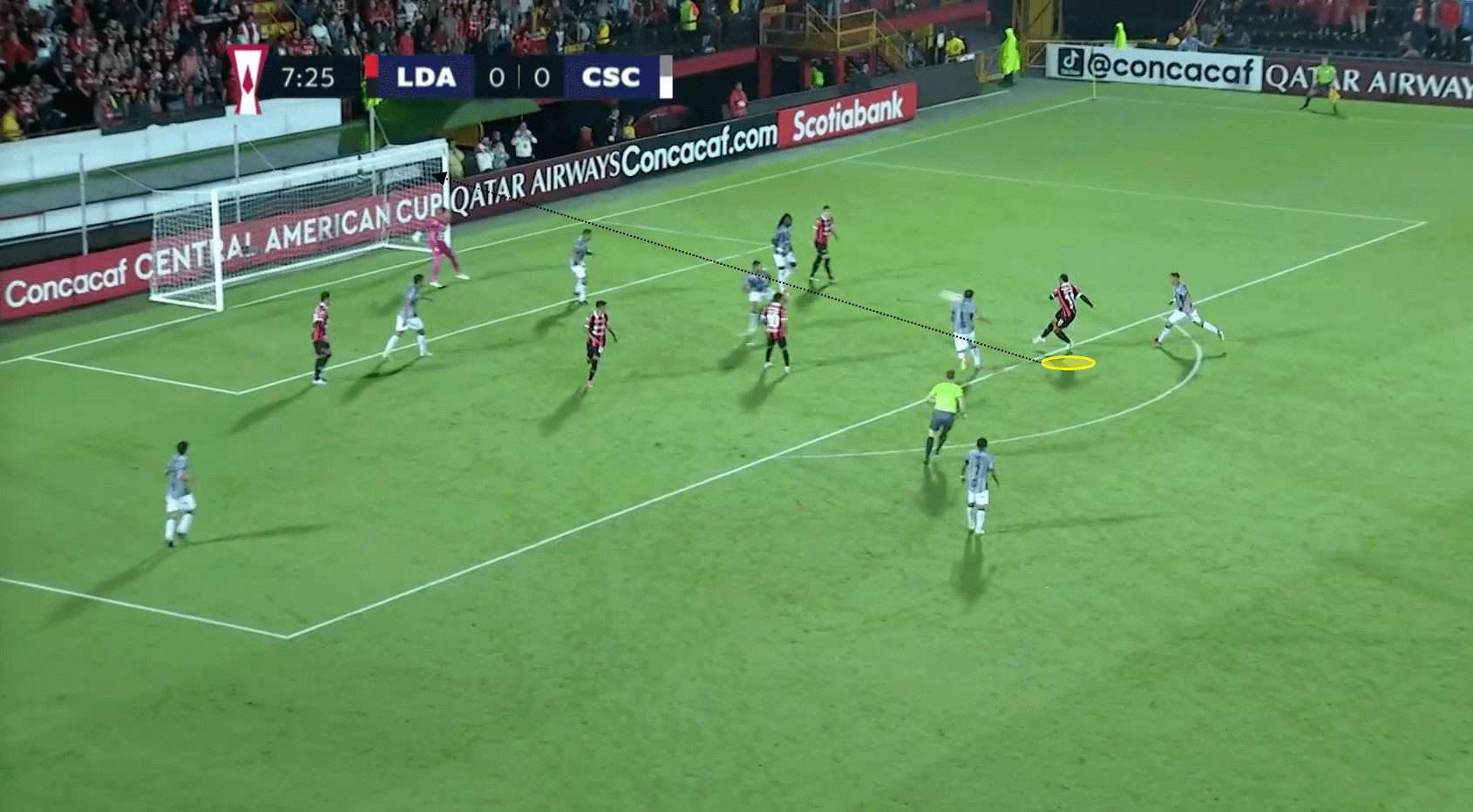
Once the overload is established, Carevic’s team then looks to exploit the resulting space on the opposite side of the pitch, as we can see in this example. The free player on the weak side often finds himself in acres of space as the opposition defence shifts to counter the overload. In this case, Ian Lawrence, the left back, has plenty of time and space to execute a cross into the penalty area.
We can also see here that the players who were overloading the right side of the pitch are making runs into the penalty area, so Lawrence has plenty of targets to aim for. In this scenario, the ball falls to Alexander López, who blasts it into the top corner from the edge of the area.
The effectiveness of this strategy lies in the disorganisation it causes in the opposing defence. Alajuelense’s rapid ball circulation and well-timed switches of play allow them to capitalise on the opposition’s defensive adjustments. Consequently, this creates opportunities for penetrating passes, crosses, or even direct goal-scoring chances.
Additionally, this tactical approach is conducive to retaining a good level of possession. Overloading one side not only attracts defenders but also allows the attacking team to circulate the ball efficiently in the congested area. Adopting a patient attacking build-up, followed by a sudden switch, can provide an avenue for ball progression without the need for 1v1 duels and battles where a turnover may be likely to occur.
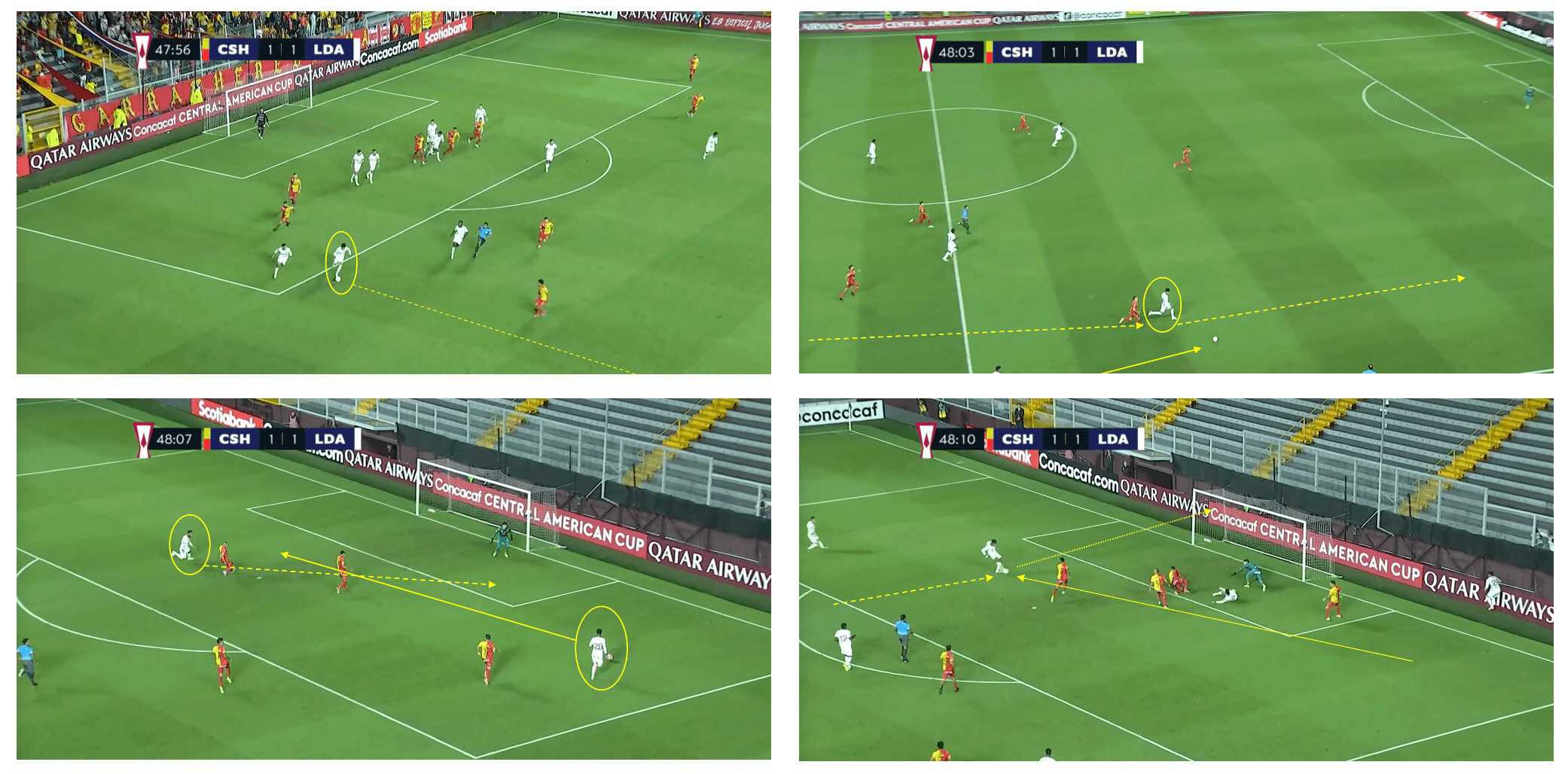
Another area that Alajuelense look to exploit is rapid attacking transitions. From an opposition corner, we can see that it takes the Costa Ricans less than 20 seconds to transition up the pitch and score a goal. One primary advantage of these rapid attacking transitions is the element of surprise.
Quick and precise passes or carries up the pitch can catch the opposition off guard when the team wins the ball back in their defensive third. The sudden change in momentum and pace can unsettle the opposing defence, creating opportunities for the Alajuelense to exploit spaces before the defenders have a chance to regroup.
Moreover, attacking transitions often capitalise on the positional disarray of the opposition. When the defensive line is transitioning from an offensive set piece such as that, there is a moment of vulnerability. Launching a counterattack quickly aims to exploit these transitional phases, where defenders may be caught out of position, allowing for goal-scoring opportunities or creating one-on-one situations.
A sound defensive structure

Argentine manager Andrés Carevic has instilled a defensive solidity in Alajuelense’s approach to the Central American Cup. The Costa Rican team typically look to sit in a 4-4-2 shape in a mid-low block and are remarkably patient in their work out of possession. They average 53.11% possession per 90 in this year’s tournament, indicating that they are more than happy to allow the opposition plenty of time on the ball.
With four defenders forming a solid line at the back and four midfielders positioned across the middle, the team achieves a well-structured and compact defensive block. This compactness makes it difficult for opponents to penetrate centrally, forcing them to play wide or attempt more challenging passes through the congested central areas.
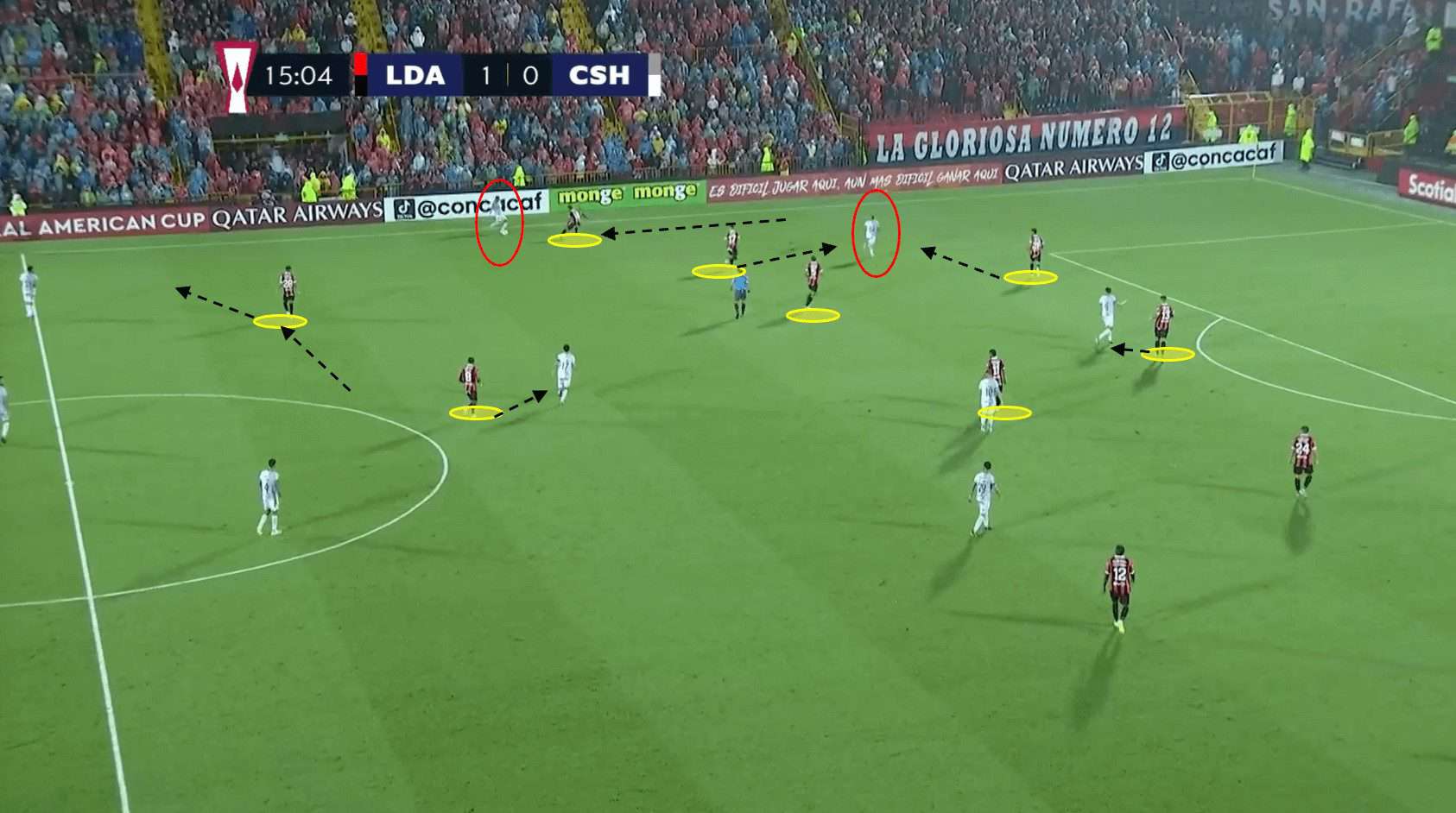
Once the ball is played into the wide areas, Alajuelense springs into action and initiates a press. In this example, the right back, Yael López, moves to press the opponent whilst the rest of the team changes their positioning to close off passing lanes.
The 4-4-2 shape also facilitates effective pressing. The two forwards in this formation can apply pressure on the opposition’s centre-backs, limiting their time and space to build from the back. This coordinated pressing can disrupt the opponent’s rhythm, create turnovers, and lead to counterattacking opportunities.
Moreover, with two forwards already positioned higher up the pitch, winning the ball back enables the team to launch rapid counterattacks. The numerical balance in midfield ensures that players are well-distributed across the pitch, providing passing options and maintaining possession during these transitions.
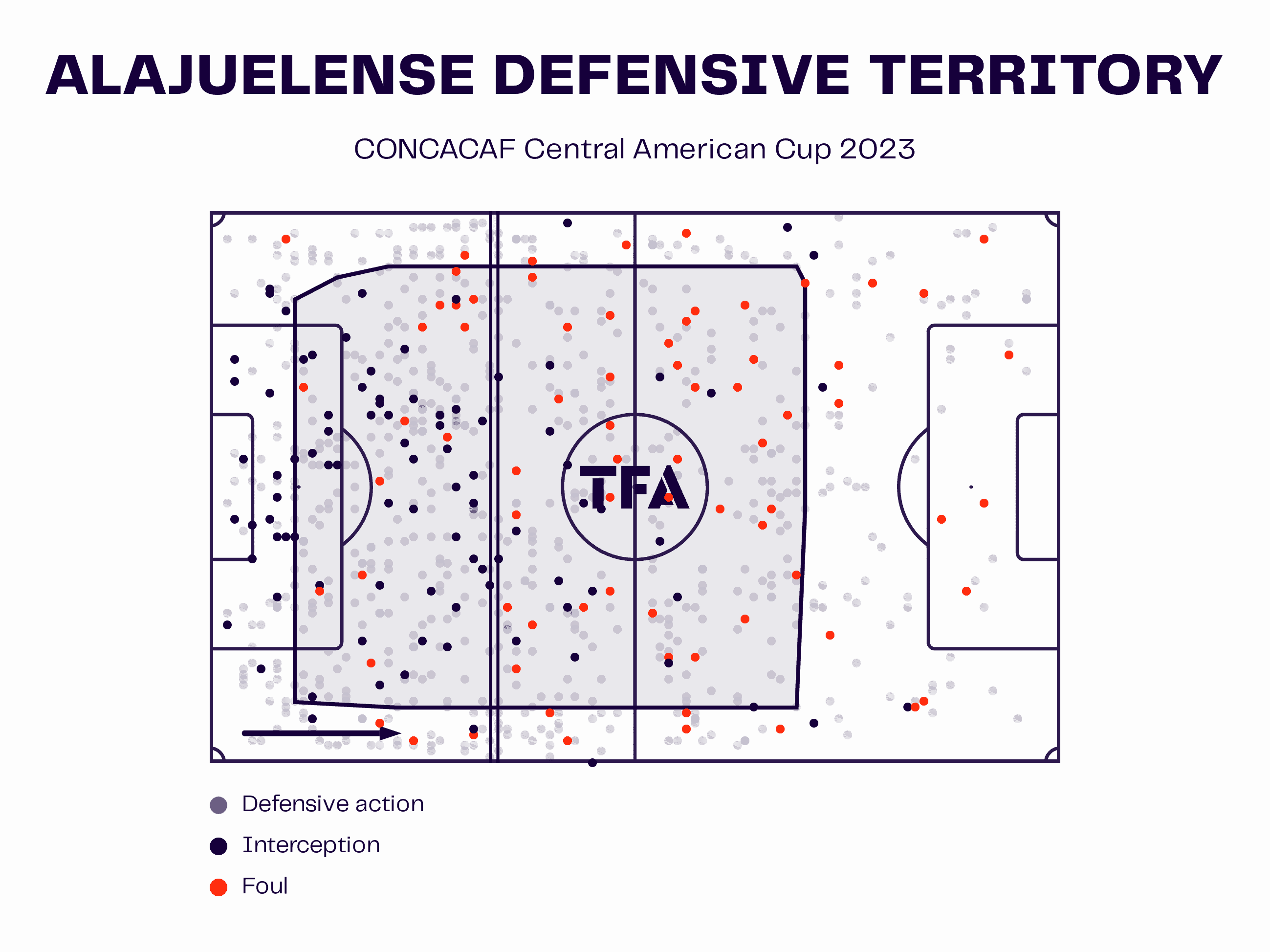
This data visual further confirms that Alajuelense like to sit in a mid-block. With a PPDA of 8.17 per 90, they are happy to let their opponents retain possession, but as we have seen, once it gets played into the wide areas, they press.
Additionally, a mid-block allows them to deny the opponent opportunities between the lines. By maintaining a compact shape, Alajuelense players can effectively close down passing lanes and limit the spaces where creative midfielders or forwards can receive the ball with time and freedom. This strategic defensive positioning is what disrupts the opponent’s rhythm and minimises their ability to build sustained attacks.
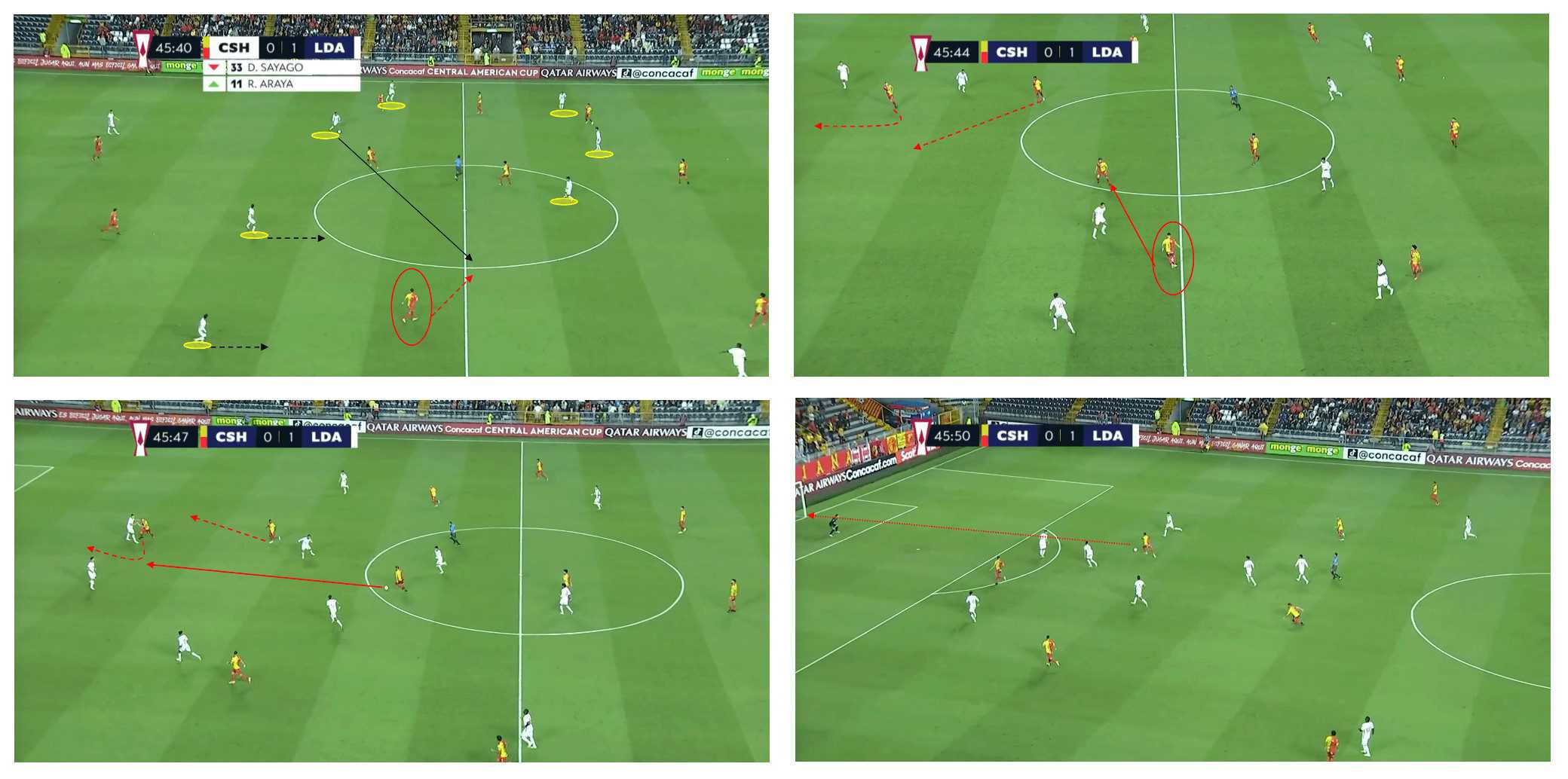
The chink in their armour can be found in the number of players they commit forward. We can see in this situation that with eight players looking to get forward in the attack, it leaves Alajuelense incredibly short in numbers when they concede possession. This facilitates the opportunity for the opposition to rapidly counterattack, and in this case, it leads to a goal.
The lack of defensive cover due to aggressive attacking play leads to numerical disadvantages during the counterattack. Suppose the opposition regains possession efficiently as they did here. In that case, Alajuelense finds themselves struggling to deal with the number of opposition players getting forward quickly, creating situations where the remaining defenders are outnumbered.
Real Estelí
Real Estelí typically line up in a 4-2-3-1 or 4-1-4-1 formation. They often look to be proactive and take the game to their opponents under Ontiel Olivas’ instructions.
Medina’s influence in the midfield
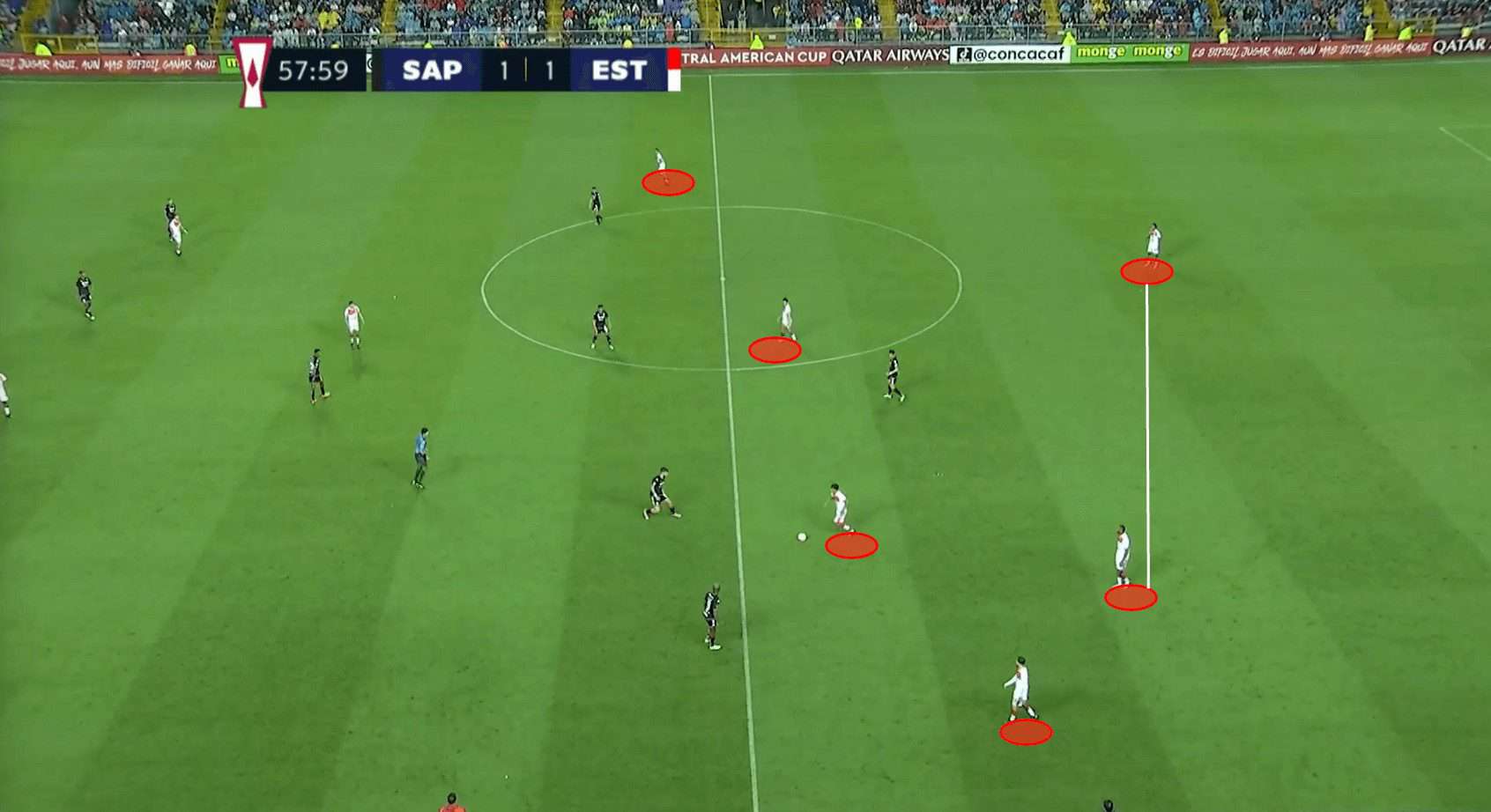
Primarily, they will look to build up in a 2-4-1-3 shape, as we can see here. Typically one of the fullbacks will push up higher when the team enters the final third, as similar to Alajulense, they like to overload one side of the pitch. This is just one of quite a few similarities between the two teams and their styles of play.
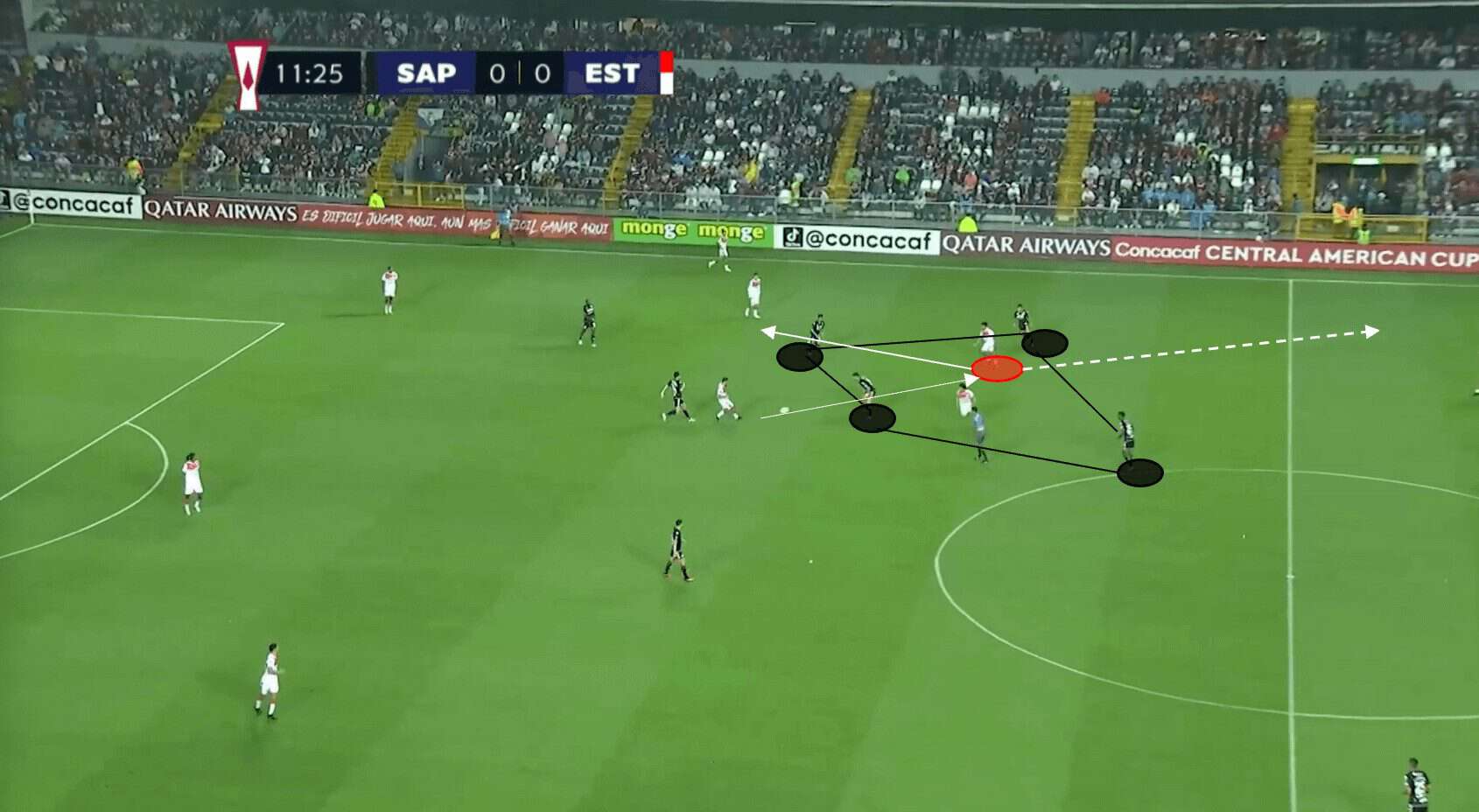
Real Estelí’s attacking build-up play is through 21-year-old playmaker Harold Medina who has gone from strength to strength with his performances in the competition. Mostly deployed as a central or attacking midfielder, he will drop back to link up the play, often dragging opposition players with him. Averaging 2.2 progressive runs per 90 and 5.35 passes into the final third per 90; he is a reliable and effective playmaker in the middle of the park.
Moreover, Medina is very aware that opponents look to mark him out of the game, but the young Nicaraguan midfielder has the tactical intelligence to use this to his and Real Estelí’s advantage. Here, we can see how capable he is when receiving the ball in tight spaces. Medina then lays it off to a teammate and makes a run into the wide area, dragging the opposition players with him and creating space in the central areas. However, when the opposition successfully marks Medina out of the game, Real Estelí can be found wanting and often resort to long passes over the top, resulting in turnovers.
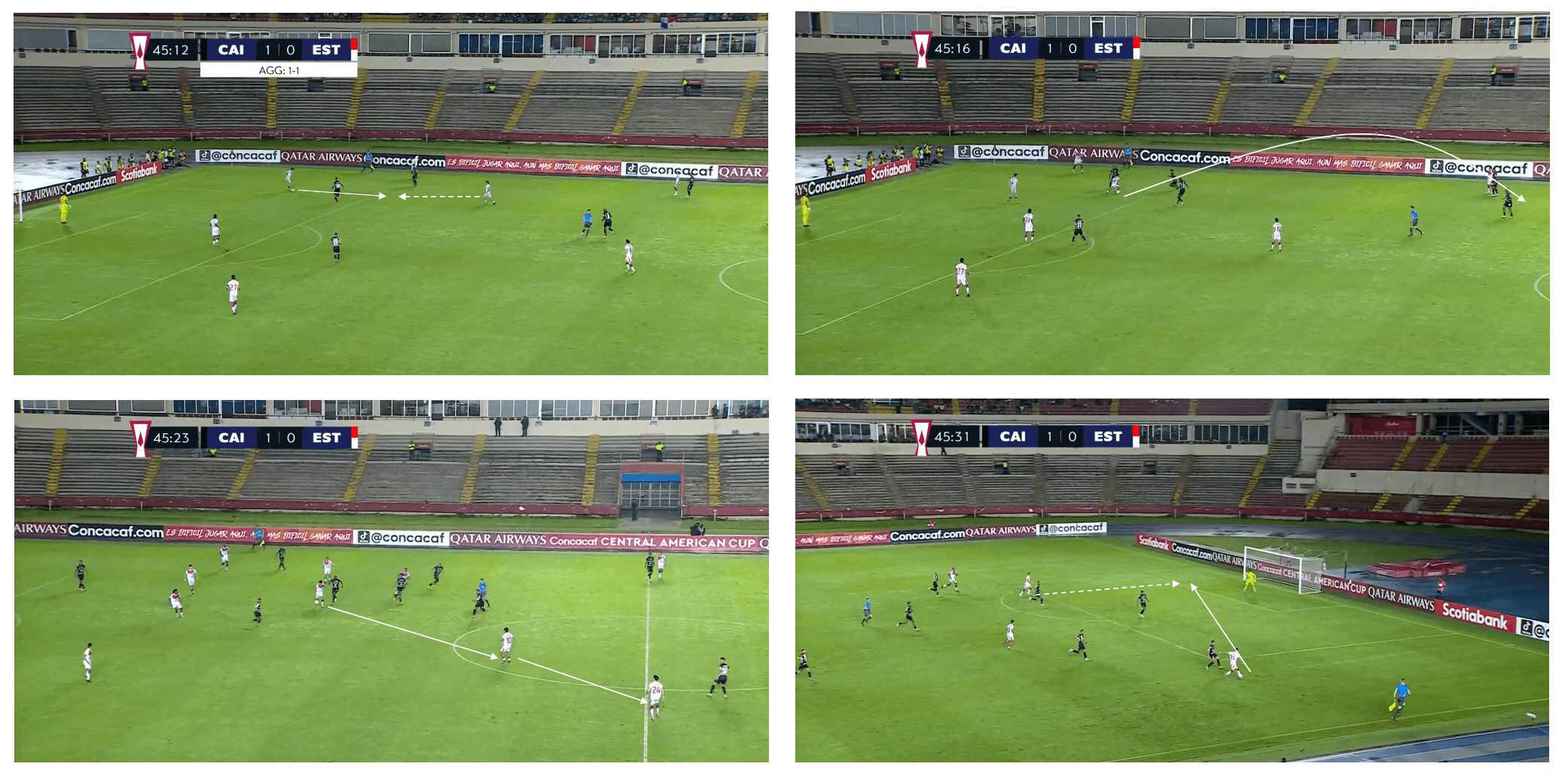
Real Estelí will also look to bait their opponents into pressing them to create spaces in the midfield areas. In this example, we can see that the Nicaraguan team passes the ball around in defence, inviting Independiente to press them in an attempt to force a turnover.
Once the Independiente players press, Real Estelí increases the tempo and plays a long pass into the midfield area, where there are spaces available to exploit. They move the ball into the feet of Medina, who plays it into the path of Méndez. The winger executes an inch-perfect cross which is promptly turned goalwards by Hernandez.
By inviting opponents to press, Real Estelí aims to manipulate the positioning of the opposing players. As the opposition commits more players forward to apply pressure, they leave space behind them.
Furthermore, the concept revolves around the principle of overcommitment. When opponents press high up the pitch, they concentrate their players in specific areas, often leaving expanses of open space elsewhere. Teams that invite the press look to exploit these areas, either through direct passes to players in open spaces or by executing quick ball circulation to shift the point of attack. The Nicaraguan team seeks to exploit these gaps by circulating the ball rapidly or playing quick one-touch passes, creating numerical superiority in key areas of the field.
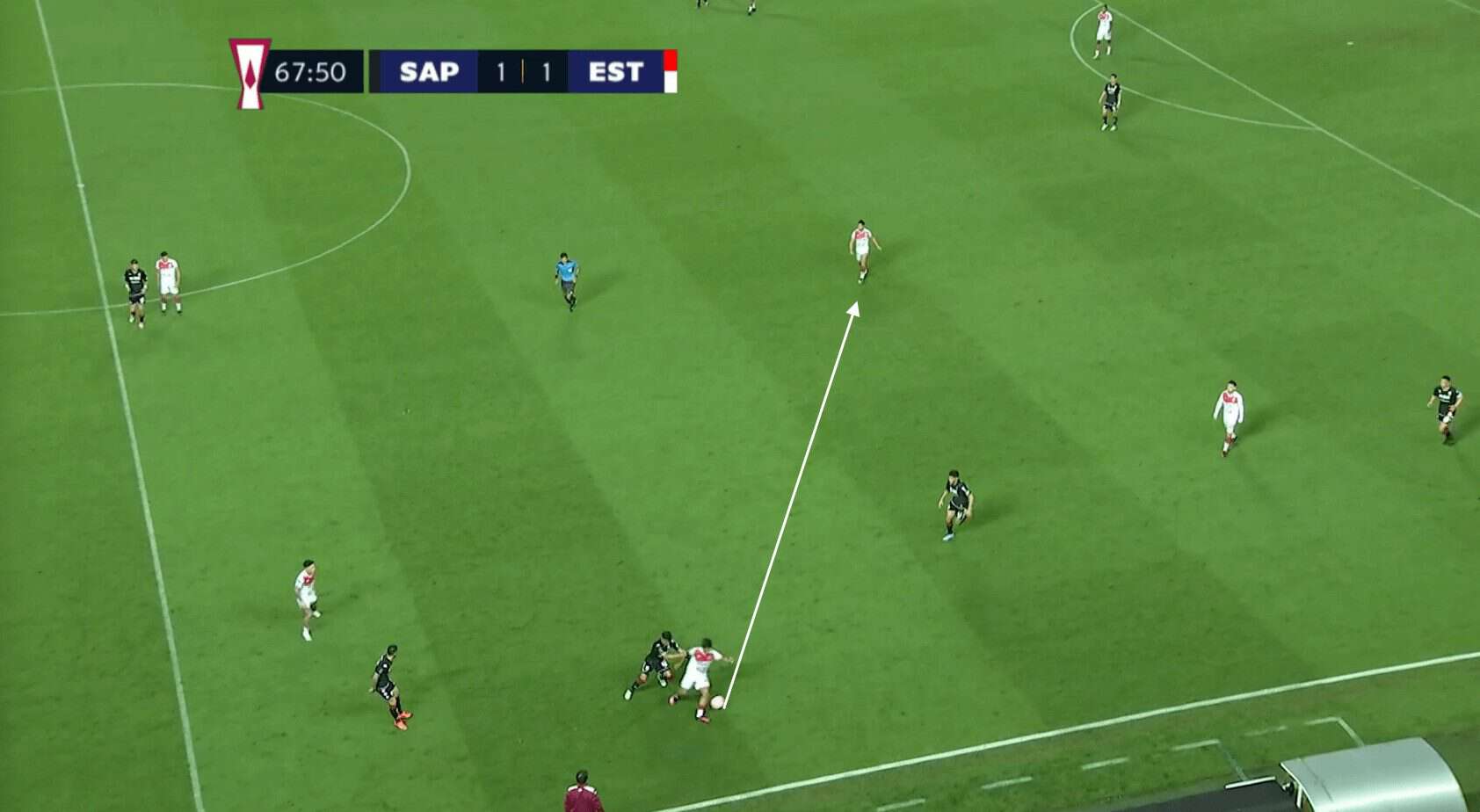
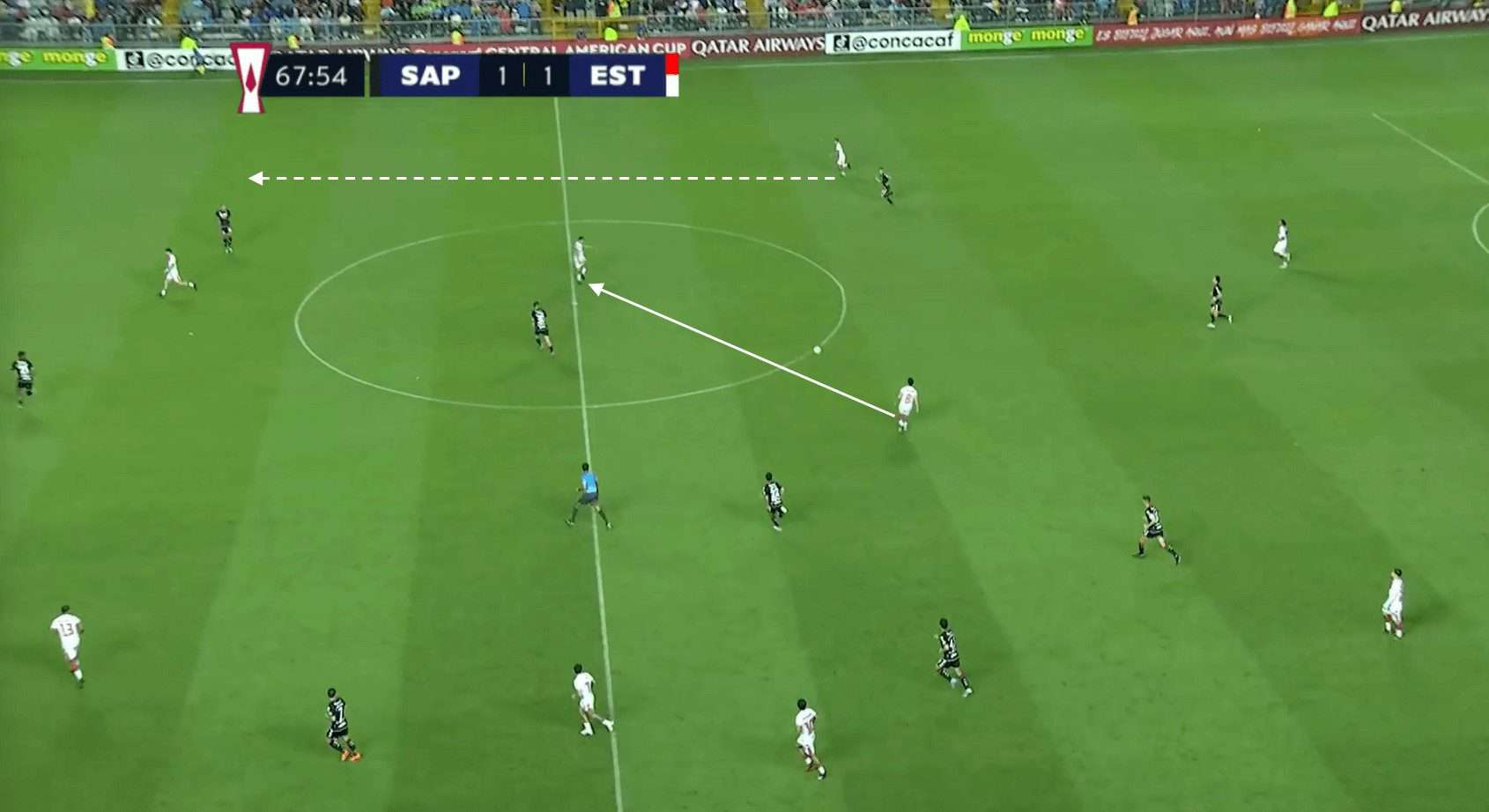
Additionally, Real Estelí looks to utilise rapid ball progression to their advantage. All it takes is two or three passes, and they are in the attacking third. Akin to what we already know about Alajuelense, this is perfect when transitioning from defence to attack. A good example of this can be seen above.
Speed in ball progression is instrumental in bypassing the opponent’s midfield. By moving the ball swiftly through the lines, Real Estelí can circumvent the congested central areas where their opponents often try to regain possession. This not only reduces the risk of turnovers in dangerous zones but also allows the attacking team to exploit spaces on the flanks or in between defensive lines.
Plus, this often puts pressure on the opposition, forcing them to retreat and defend in deeper positions. When Real Estelí advances quickly, it limits the time defenders have to assess and react, creating opportunities to exploit spaces behind the defensive line. This proactive approach often catches defenders on the back foot, providing the Nicaraguan team with a strategic advantage.
Adaptability in defence
Olivas has brought a fairly adaptable defensive structure to Real Estelí. They will mostly sit in a mid-block and are happy to let the opposition pass the ball around in defence. Real Estelí seeks to close off the passing lanes and force the opposition to go long, increasing the likelihood of a turnover.
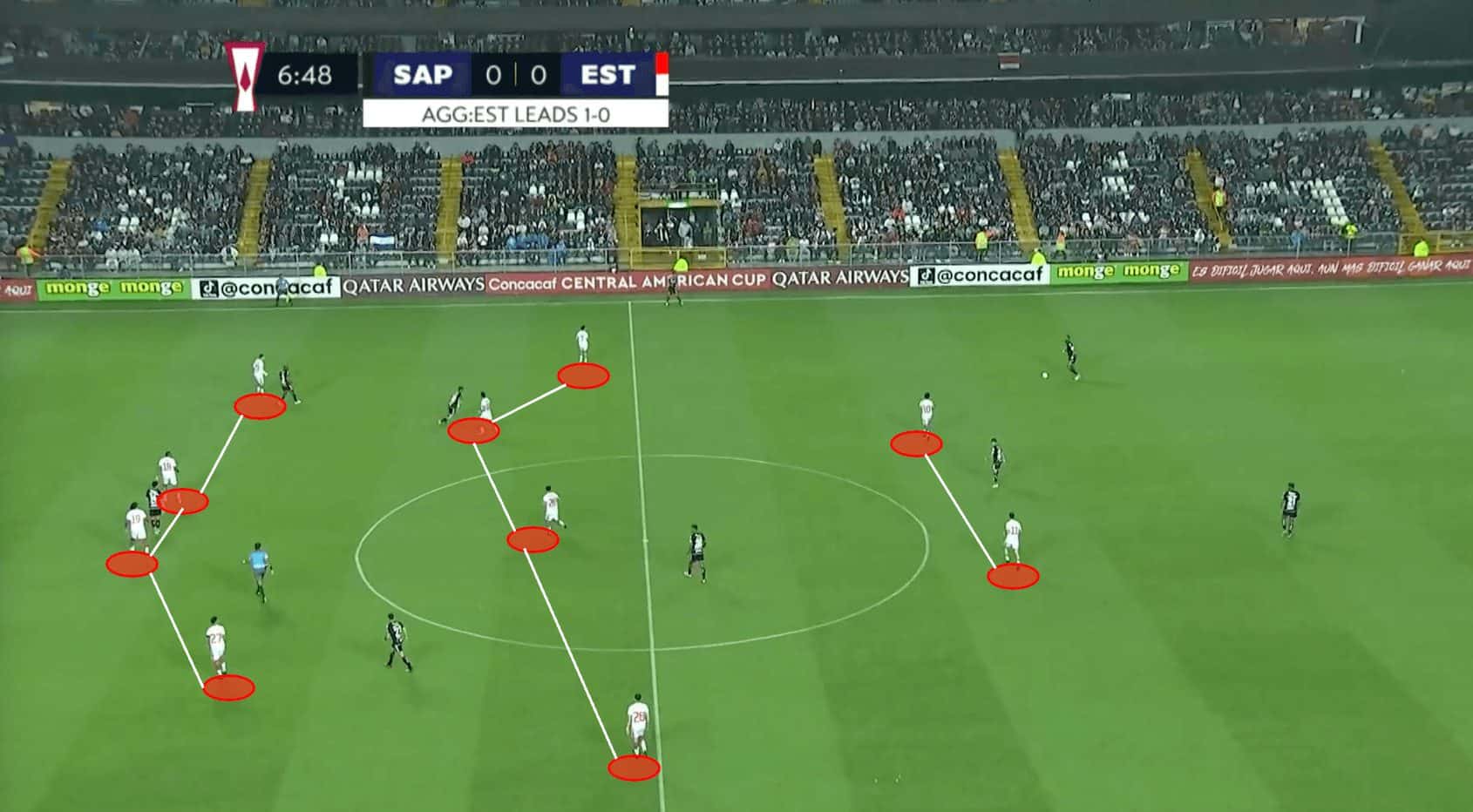
They will usually start with a 4-4-2 defensive structure, as shown here. This allows them to remain compact and prevent the opposition from being able to play through the lines. Plus, it allows them to close off the passing lanes whilst not conceding too much space to their opponents.
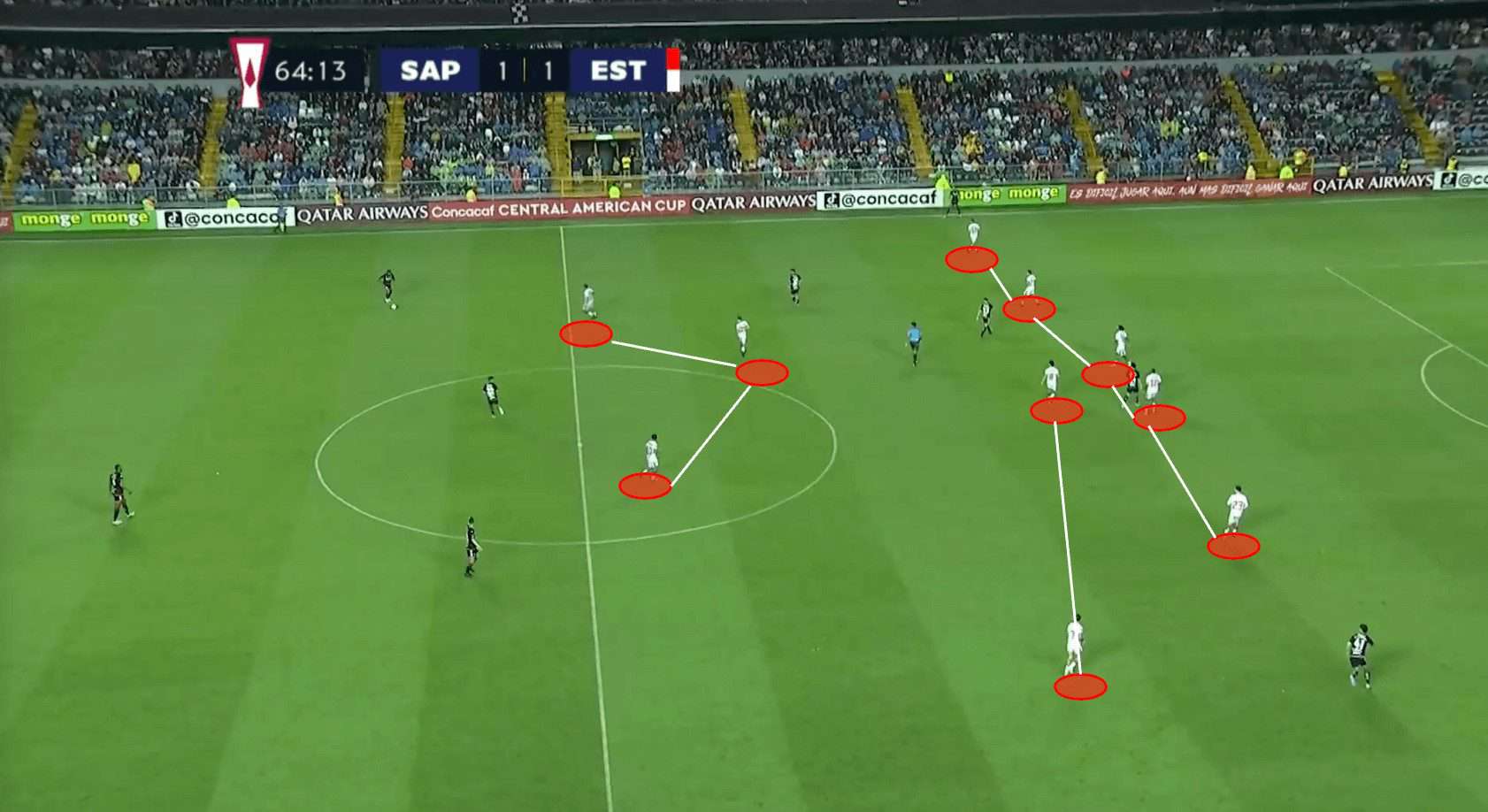
However, Real Estelí’s defensive shape will continuously change throughout the game depending on their opposition’s attacking play. We can see here that they have changed to something of a 5-2-3 structure. By changing shape based on the evolving circumstances of the match, the team can effectively tailor its defensive approach to counter the strengths and exploit the opposition’s weaknesses. Whether facing a possession-oriented team or one reliant on quick counterattacks, Real Estelí’s ability to adjust defensive shape provides a strategic edge.
Moreover, this adaptability also allows for a proactive response to in-game developments. If the opposition introduces new tactics or exploits specific areas of the pitch, an adaptable defensive structure enables quick adjustments. This responsiveness minimises the risk of being predictable and makes it challenging for opponents to find consistent success against a well-prepared defence.
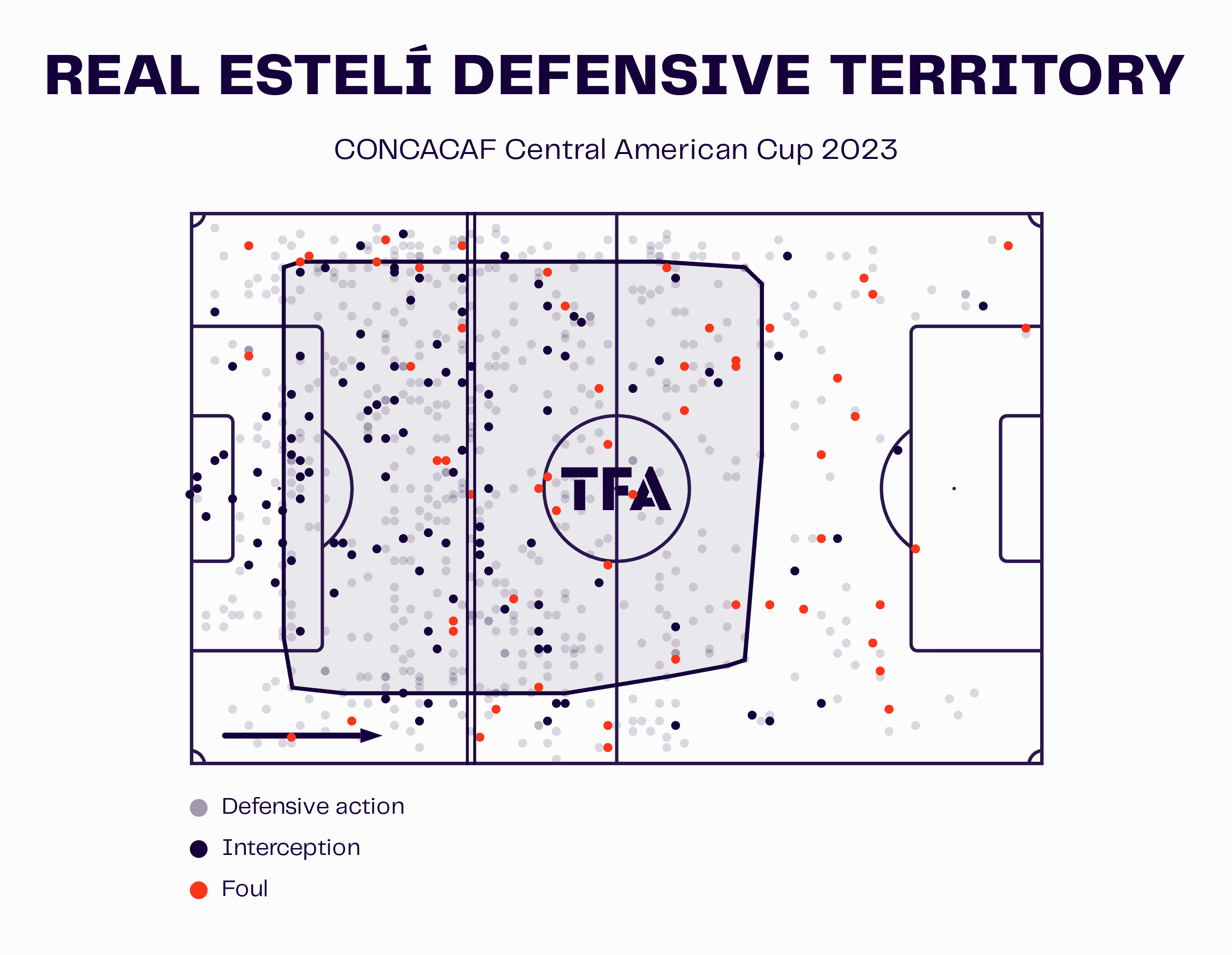
Finally, as we can see here, Real Estelí will typically sit in a mid-block, much like Alajulense. With a PPDA of 8.8 per 90 and an average of 52.08% possession per 90 in this competition, they are more than happy to allow the opposition time on the ball. They respond to the set of circumstances in front of them and are incredibly adept at thwarting their opponent’s attacking plays, hence why they have only conceded 6 goals in this competition so far.
Conclusion
The CONCACAF Central American Cup final will be an incredibly close affair as there are actually many similarities between the two teams. Perhaps Alajeuelense have the more potent attack, but if they give Harold Medina space in midfield, he will make this happen. Plus, Real Estelí have shown how defensively resilient they are with their adaptive structure and hard-working mentality.
Overall, Alajulense might just have the edge, but in cup finals, anything can happen. This has been a fantastic competition to watch, and hopefully, the final will follow suit, and we will witness some brilliant football.





Comments